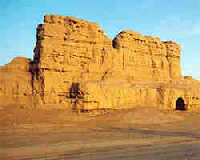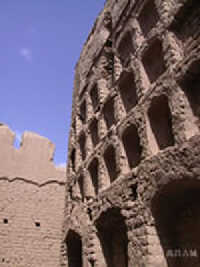| |
Ancient City of Gaochang
( 2005-09-13 )
 The Ancient City of Gaochang lies at the foot of theFlaming Mountain, about 45 kilometers southeast of theTurpanCounty seat, which has been a must passageway for communication between the East and the West since ancient times, and an important section of the ancientSilk Road. In 1961, theState Councillisted it as one of the key national cultural relics units under protection. The Ancient City of Gaochang lies at the foot of theFlaming Mountain, about 45 kilometers southeast of theTurpanCounty seat, which has been a must passageway for communication between the East and the West since ancient times, and an important section of the ancientSilk Road. In 1961, theState Councillisted it as one of the key national cultural relics units under protection.
The construction of the city of Gaochang started in the first century BC. First called Gaochangbi, it was a key point on the ancient Silk Road, but after many changes in fortune over a period of 1,300 years, and under the jurisdictions of the Gaochang Prefecture, the Gaochang Kingdom and Huozhou Prefecture, the city was burnt down in wars at the end of the 13th century.
 The Ancient City of Gaochang consists of the outer city, the inner city, and the palace city. The walls of city, basically well preserved, divide the city into three parts: the inner city, the outer city, and the palace city. The Ancient City of Gaochang consists of the outer city, the inner city, and the palace city. The walls of city, basically well preserved, divide the city into three parts: the inner city, the outer city, and the palace city.
The outer city is in a shape of rectangle with perimeter of about 5 kilometers, occupying an area of 2 million square meters. The walls were built of tamped (packed down) earth and the foundation is 11.5 meters high and 12 meters wide. There are outstanding battlements on the outside of the city walls. There are two gates on each side of the outer city: The two on the west side with defense enclosures outside the gates are the best preserved, from one of which, the small town outside the city gate can still be seen.
The southeast and southwest part of the outer city is thetemplearea. The bigger temple area lies on the southwest part of the city. The original of the ruins are the gate of temple, yard, main hall, and the pagoda basement of storied niches, and some remaining murals and figures of Buddha can still be vaguely seen in the niches. Some ruins of "workshops" and "fairs" still exist in the northeast and southeast outside the ancient city; perhaps the workshops were ruins of a small handcraft industry.
|
|

